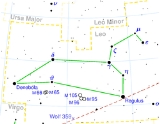
Denebola
Overview
Constellation
In modern astronomy, a constellation is an internationally defined area of the celestial sphere. These areas are grouped around asterisms, patterns formed by prominent stars within apparent proximity to one another on Earth's night sky....
Leo
Leo (constellation)
Leo is one of the constellations of the zodiac. Its name is Latin for lion. Its symbol is . Leo lies between dim Cancer to the west and Virgo to the east.-Stars:...
. It is an A-class star that is about 36 ly distant from earth, and has a luminosity about twelve times that of the sun. Its apparent magnitude
Apparent magnitude
The apparent magnitude of a celestial body is a measure of its brightness as seen by an observer on Earth, adjusted to the value it would have in the absence of the atmosphere...
is 2.14. Denebola is a Delta Scuti type
Delta Scuti variable
A Delta Scuti variable is a variable star which exhibits variations in its luminosity due to both radial and non-radial pulsations of the star's surface. Typical brightness fluctuations are from 0.003 to 0.9 magnitudes in V over a period of a few hours, although the amplitude and period of the...
variable star
Variable star
A star is classified as variable if its apparent magnitude as seen from Earth changes over time, whether the changes are due to variations in the star's actual luminosity, or to variations in the amount of the star's light that is blocked from reaching Earth...
, meaning its luminosity varies very slightly over a period of a few hours.
Its name is shortened from , from the Arabic
Arabic language
Arabic is a name applied to the descendants of the Classical Arabic language of the 6th century AD, used most prominently in the Quran, the Islamic Holy Book...
phrase "tail of the lion", as it represents the lion's tail—the star's position in the Leo constellation.
Unanswered Questions
Discussions

